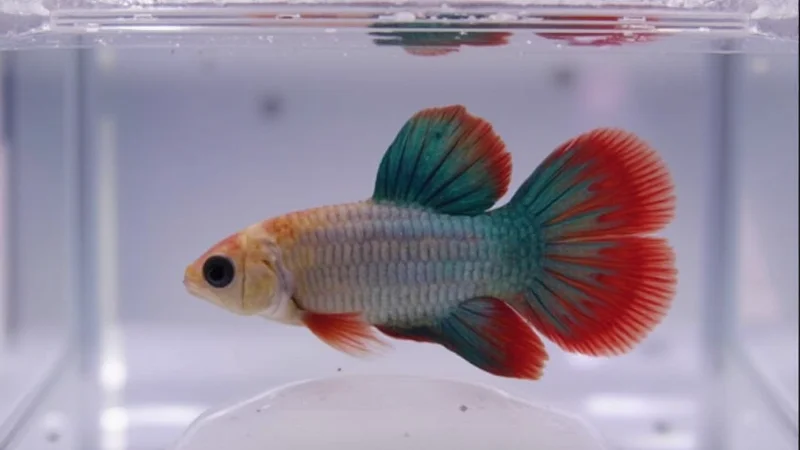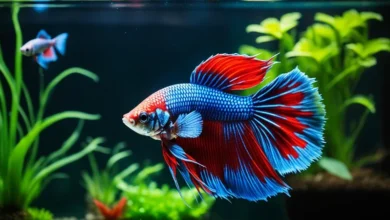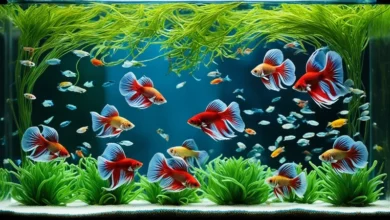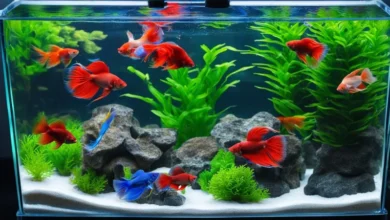
The Double Tail Betta (Betta splendens) is one of the most captivating varieties in the betta world, characterized by its distinctive twin caudal fin that creates a dramatic, flowing appearance. These fish have gained tremendous popularity among aquarists and breeders alike for their unique aesthetic appeal and genetic complexity. Breeding Double Tail Bettas can be a rewarding adventure and a fascinating journey into fish genetics.
Whether you’re a seasoned breeder looking to perfect your Double Tail bloodlines or a hobbyist eager to try breeding for the first time, this comprehensive guide will walk you through every step of the Double Tail Betta breeding process. From selecting the perfect breeding pair to raising healthy fry, we’ll cover all the essential knowledge and techniques you need for successful Double Tail Betta breeding.
Understanding Double Tail Bettas
Before diving into the breeding process, it’s important to understand what makes Double Tail Bettas unique. Unlike standard Bettas with a single caudal fin, Double Tail Bettas possess a genetic mutation that splits their tail into two distinct lobes.
This mutation typically affects not just the tail but often results in wider dorsal and anal fins as well, creating a more balanced and symmetrical appearance when viewed from the side.
“The Double Tail mutation is one of the most fascinating genetic developments in ornamental Betta breeding, transforming the fish’s silhouette while presenting unique breeding challenges.”
Advanced Betta Genetics Journal
Characteristics of Quality Double Tail Bettas
When planning to breed Double Tail Bettas, knowing what constitutes quality specimens is crucial:
- Even Tail Separation: The two tail lobes should be clearly defined with a complete separation down to the base
- Balanced Proportions: Ideally, both lobes should be roughly equal in size and shape
- Enhanced Dorsal Fin: Quality Double Tails typically have larger dorsal fins that match the anal fin in size
- Strong Body Structure: The body should be robust yet proportional, avoiding excessive shortening
- Vibrant Coloration: Colors should be intense and consistent across the body and fins
Selecting Breeding Pairs
Choosing the right breeding pair is perhaps the most crucial step in the entire breeding process. The genetics of Double Tail Bettas can be complex, and careful selection will greatly impact your success rate and the quality of offspring.
Health Indicators
Before considering genetics, ensure both potential breeding fish are in optimal health:
- Active swimming behavior without lethargy
- Clear, bright eyes without cloudiness
- Intact fins without rot or damage
- Good appetite and responsiveness
- No visible signs of disease or parasites
- Proper body weight (neither too thin nor bloated)
Genetic Considerations
When it comes to Double Tail Betta breeding, genetics play a significant role in determining outcomes:
| Breeding Combination | Expected Results | Notes |
|---|---|---|
| Double Tail × Double Tail | ~25-50% Double Tail, possible deformities | Highest yield but higher risk of defects |
| Double Tail × Single Tail (DT gene carrier) | ~25% Double Tail | Moderate yield, healthier fry |
| Double Tail × Single Tail (non-carrier) | 0% Double Tail, 100% carriers | For expanding breeding stock |
For beginners, the most recommended approach is pairing a strong Double Tail male with a single Tail female who has a Double Tail in her genetic background. This combination typically produces healthier fry with a reasonable percentage of Double Tail offspring.
Pro Tip: When selecting your breeding stock, consider working with a breeder who can provide information about the genetic background of their fish. This transparency can help you make more informed decisions about compatible breeding pairs.
Age Considerations
For optimal breeding results:
- Males: 4-12 months old
- Females: 4-8 months old
Fish that are too young may not be fully sexually mature, while older specimens may have decreased fertility or lower energy levels needed for successful spawning.
Setting Up a Breeding Tank

Creating the proper environment for breeding is essential for success. Double Tail Bettas require specific tank conditions to trigger spawning behavior and ensure the safety of eggs and fry.
Tank Requirements
For breeding Double Tail Bettas, your setup should include:
- Tank Size: 5-10 gallon tank (smaller tanks are easier to maintain and help the male locate eggs)
- Water Depth: 4-6 inches (10-15 cm)
- Temperature: 78-82°F (25.5-27.8°C)
- pH Level: 6.8-7.2 (slightly acidic to neutral)
- Filtration: Gentle sponge filter or no filtration during spawning
- Lighting: Subdued, indirect lighting
- Cover: Secure lid (males can jump during breeding)
Essential Equipment
- Heater with thermostat: Maintaining a stable temperature is crucial
- Thermometer: For monitoring water temperature
- Indian Almond Leaves or Catappa Leaves: Releases tannins that help condition the water and may encourage spawning
- Spawning Mop or Plants: Provides cover and spawning sites
- Breeding Cone or Cup: For bubble nest building
- Isolation containers: For separating the female after spawning
Setting Up the Tank
- Clean the tank thoroughly without using soap or chemicals
- Install a gentle heater and set it to 80°F (26.7°C)
- Add pre-conditioned water (aged for 24-48 hours)
- Place 1-2 Indian almond leaves in the tank
- Add floating plants or a spawning mop in one corner
- Place a breeding cone or half styrofoam cup floating in the tank
- Set up a divider initially to allow the pair to see each other without physical contact
Important: Never use untreated tap water for breeding tanks. Chlorine, chloramine, and heavy metals can kill eggs and fry. Always use a quality water conditioner or aged water.
Conditioning the Breeding Pair
Proper conditioning is essential to trigger spawning behavior and ensure healthy eggs and fry. This process typically takes 1-2 weeks of dedicated preparation.
Nutritional Conditioning
Feed your Double Tail Bettas high-protein foods 2-3 times daily:
- Live foods (best option):
- Brine shrimp
- Daphnia
- Bloodworms
- Mosquito larvae
- Frozen alternatives:
- Frozen bloodworms
- Frozen brine shrimp
- Frozen daphnia
- High-quality pellets as supplements
The goal is to build up the female’s egg supply and ensure both fish have sufficient energy reserves for the demanding breeding process.
Visual Conditioning
Before introducing the breeding pair directly:
- Place the female in a clear container or behind a divider within the breeding tank
- Allow the male to see her for 1-3 days
- Monitor their interaction – the male should begin building a bubble nest, and the female should display vertical breeding stripes when ready
Signs of Readiness
For males:
- Active bubble nest building
- Flaring and displaying fins
- Dancing or zigzag swimming pattern when seeing the female
For females:
- Visible vertical stripes (breeding bars)
- Swollen belly with visible ovipositor (white dot between ventral fins)
- Responsive to male’s displays
The Spawning Process
The actual spawning of Double Tail Bettas is an intricate dance that requires careful observation and sometimes intervention.
Introduction Process
- Ensure both fish show signs of readiness
- Release the female into the breeding tank during evening hours (Bettas typically spawn in the early morning)
- Monitor the pair continuously for the first hour, then check regularly
- Be prepared to remove the female if aggression becomes excessive
The Spawning Embrace
When both fish are ready:
- The male will entice the female under his bubble nest
- He will wrap his body around hers in what’s called the “spawning embrace”
- During this embrace, the female releases eggs while the male releases milt (sperm)
- Eggs will sink slowly to the bottom
- The male will collect fallen eggs in his mouth and place them in the bubble nest
This process can repeat 5-20 times over several hours, with the female releasing 10-40 eggs per embrace.
Post-Spawning Care
Once spawning is complete:
- The female should be removed immediately to prevent the male from attacking her
- The male will remain to tend the nest and care for the eggs
- Maintain water temperature strictly between 78-82°F (25.5-27.8°C)
- Keep lighting dim and minimize vibrations around the tank
- Do not feed the male during this period (24-36 hours) as he will be focused on nest maintenance
Caring for the Fry
Double Tail Betta fry requires meticulous care, especially in the first few weeks of life. Their development occurs in several distinct stages, each with unique requirements.
Egg to Free-Swimming Fry Timeline
| Stage | Timeframe | Description |
|---|---|---|
| Eggs in nest | 0-24 hours | Fry begins swimming horizontally and need feeding |
| Hatching | 24-48 hours | Fry emerge with yolk sacs attached |
| Hanging fry | 48-72 hours | Fry hang vertically, consuming yolk sacs |
| Free-swimming | 72-96 hours | Fry begins swimming horizontally and needs feeding |
Removing the Male
Once fry become free-swimming (usually by day 3-4):
- Gently remove the male with a small container
- Be extremely careful not to disturb the fry or create strong water currents
- The male should be returned to his tank and fed well to recover
First Foods for Fry
Double Tail Betta Fry needs extremely small foods initially:
- Infusoria (microscopic organisms)
- Commercial fry foods (liquid)
- Newly hatched baby brine shrimp (after 7-10 days)
- Finely crushed flake food (after 3-4 weeks)
Feeding schedule:
- Feed 3-5 times daily in very small amounts
- Remove uneaten food after 30 minutes to prevent water quality issues
Water Changes
Maintaining water quality is critical but must be balanced with minimal disturbance:
- Days 1-7: No water changes (very delicate stage)
- Days 8-14: 10% daily water change using a drip line or airline tubing
- Days 15-30: 20% daily water change
- After 30 days: 30-50% water change every 2-3 days
Always ensure replacement water matches the tank temperature exactly and has been aged or treated.
Growth and Development
Double Tail Betta fry develops at varying rates:
- Week 1-2: Tiny transparent fry, developing internal organs
- Week 3-4: Fin development begins, colors start showing faintly
- Week 5-8: Double tail characteristic becomes visible in some fry
- Week 9-12: Juvenile stage, males and females becoming distinguishable
- Week 12-16: Young adults, coloration intensifying
Growth Tip: Separate faster-growing fry from smaller siblings around week 6-8 to prevent bullying and ensure more even growth rates across your spawn.
Genetics of Double Tail Bettas
Understanding the genetics behind the Double Tail trait can help breeders make more informed decisions and anticipate results.
The Double Tail Gene
The Double Tail trait in Bettas is governed by a recessive gene (dt). This means:
- A fish must inherit two copies of the gene (dt/dt) to display the double-tail phenotype
- Fish with one copy (Dt/dt) are carriers but show normal single tails
- Non-carrier fish have two dominant genes (Dt/Dt)
Inheritance Patterns
When breeding Double Tail Bettas, expect these inheritance patterns:
Double Tail (DT/dt) × Double Tail (DT/DT):
- 100% Double Tail offspring (dt/dt)
- Higher risk of spinal deformities and reduced swim bladder function
Double Tail (DT/dt) × Carrier Single Tail (Dt/DT):
- 50% Double Tail offspring (dt/dt)
- 50% Carrier Single Tail offspring (Dt/dt)
- Generally healthier offspring with fewer deformities
Double Tail (DT/dt) × Non-carrier Single Tail (Dt/Dt):
- 0% Double Tail offspring
- 100% Carrier Single Tail offspring (Dt/dt)
Genetic Challenges
Double Tail breeding comes with genetic considerations:
- Shortened Body: Double Tails often have shorter, more compact bodies
- Swim Bladder Issues: Some Double Tails have compromised swim bladder function
- Spinal Deformities: More common in Double Tail × Double Tail spawns
- Reduced Fertility: Some Double Tail males may have reduced fertility
To minimize these issues, many experienced breeders recommend:
- Outcrossing to single tails periodically
- Selecting breeding stock with longer bodies
- Avoiding breeding fish with obvious deformities
- Culling severely deformed fry humanely
Common Problems and Solutions
Even experienced breeders encounter challenges when breeding Double Tail Bettas. Here are solutions to common issues:
Spawning Issues
| Problem | Possible Cause | Solution |
|---|---|---|
| No bubble nest | Temperature too low, male not ready | Increase temperature to 80°F, give more time |
| Male attacks female | Female not ready, improper introduction | Remove female, try visual conditioning longer |
| No spawning after introduction | Insufficient conditioning, stress | Better conditioning with live foods, ensure privacy |
| Eggs not fertilized | Poor male condition, timing issues | Improve male’s diet, ensure proper conditioning |
Fry Development Problems
| Problem | Possible Cause | Solution |
|---|---|---|
| High fry mortality | Poor water quality, inadequate food | More frequent water changes, better first foods |
| Slow growth | Low temperature, insufficient feeding | Maintain 80-82°F, feed more frequently |
| Deformities | Genetic issues, water parameters | Selective breeding, maintaining optimal water quality |
| Uneven growth | Competition for food | Separate fry by size, feed in multiple locations |
Final Tips for Success
Breeding Double Tail Bettas successfully requires patience, attention to detail, and dedication. Here are some final tips from experienced breeders:
- Keep Detailed Records: Document spawning dates, parental characteristics, growth rates, and outcomes
- Start Small: Begin with one breeding pair rather than multiple simultaneous spawns
- Plan Ahead: Ensure you have adequate space and resources for potentially hundreds of growing fry
- Join Communities: Connect with other Double Tail Betta breeders to share experiences and advice
- Be Patient: Quality breeding programs develop over years, not weeks or months
- Ethical Considerations: Have a plan for rehoming surplus fish before you begin breeding
Conclusion
Breeding Double Tail Bettas is a fascinating journey that combines art, science, and dedication. While it presents unique challenges due to the genetic complexities of the Double Tail trait, the reward of producing healthy, vibrant fish with stunning double caudal fins makes the effort worthwhile.
Remember that successful breeding is about more than just producing large numbers of fish—it’s about contributing to the improvement and preservation of this beautiful variety through thoughtful selection and responsible breeding practices. By following the guidelines in this comprehensive guide, you’ll be well on your way to breeding healthy, stunning Double Tail Bettas that will bring joy to fellow enthusiasts.
Whether you’re breeding for show-quality specimens, to develop new color combinations, or simply for the enjoyment of the process, the knowledge and techniques shared here will help you achieve your Double Tail Betta breeding goals.
Have questions about Double Tail Betta breeding or want to share your experiences? Leave a comment below or join our community forum for ongoing support and discussion!



